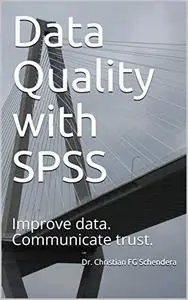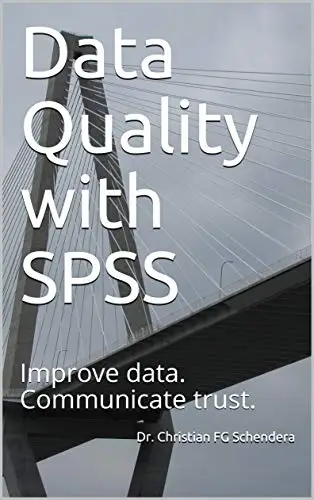Data Quality with SPSS: Improve data. Communicate trust.
By Dr. Christian FG Schendera
English | 2021 | ASIN : B08P7TJN2Q | 639 Pages | EPUB | 7.6 MB
By Dr. Christian FG Schendera
English | 2021 | ASIN : B08P7TJN2Q | 639 Pages | EPUB | 7.6 MB
This world-wide only book about data quality with SPSS provides you with a real Swiss Army knife:
● Learn about data quality
● Recognize data problems
● Understand consequences of data problems
● Solve data problems = establish data quality
● Communicate data quality
This book systematically presents the most important criteria for data quality with SPSS: Completeness, consistency, plausibility and how to deal with duplicates, missings and outliers. And in later chapters some more.
The book contains countless real-world examples, from typical dirty data desasters you find in the daily news to the interesting role of outliers in questioning original expectations regarding the ozone concentration over Antarctica.
Chapter 1: The most common problem areas, e.g. completeness, uniformity, duplicates, missings, outliers and plausibility. A scheme illustrates the interrelationships of the criteria and the fundamental importance of the quality of data. Further criteria for the quality of data, as well as their communication, are presented in chapters 13 and 19.
Chapter 2: Basic conditions for the production of data quality, among other things resources, the prioritization of goals (relevance) and control by protocols (SPSS syntax).
Chapter 3: First control possibilities for the completeness of data sets, cases (rows), variables (columns) and values or missings.
Chapter 4: Numerous possibilities to identify inconsistencies or to standardize in numerical values, time units and strings.
Chapter 5: Identify, understand and (if necessary) filter multiple values or data rows.
Chapter 6: Dealing with missing data. After assessing causes (patterns), consequences, extent and mechanisms, numerous methods of handling are discussed, from imputation to multivariate estimates (MVA).
Chapter 7: Identify, understand and handle outliers. The special role of expectation ("frames") is discussed.
Chapter 8: Qualitative and quantitative approaches to plausibility testing. The examination of the multivariate quality of data is presented using a qualitative and also a quantitative (anomaly) approach.
Chapter 9: Checking several variables and criteria by means of validation rules ("Validation" or SPSS procedure VALIDATEDATA).
Chapter 10: Numerous examples for checking several values, rows and columns in a data set at once. The numerous variants of counting variables (counters) presented are likely to be of particular interest.
Chapter 11: Numerous other examples of working with several (separate) data sets at once, e.g. using macros to screen, split or merge several data sets.
Chapter 12: Time or date-related problems, and how to recognize and solve them.
Chapter 13: Further criteria for the quality of data, e.g. quantity, unambiguity, relevance, accuracy or comprehensibility.
Chapter 16: Nodes for data quality and data preparation in IBM SPSS Modeler.
Chapter 18 contains a list of selected criteria that users can use to log the way in which quality criteria are implemented.
Chapter 19 provides annotated criteria for communicating the quality of data, surveys and analyses, including the correct interpretation and communication of the concept of significance. A separate chapter highlights the "deadly sins" of professional work. And their not so pretty consequences.
This book is important for all those who work with SPSS and whose results depend on reliable data. Data quality is not everything, but without data quality everything is nothing.



